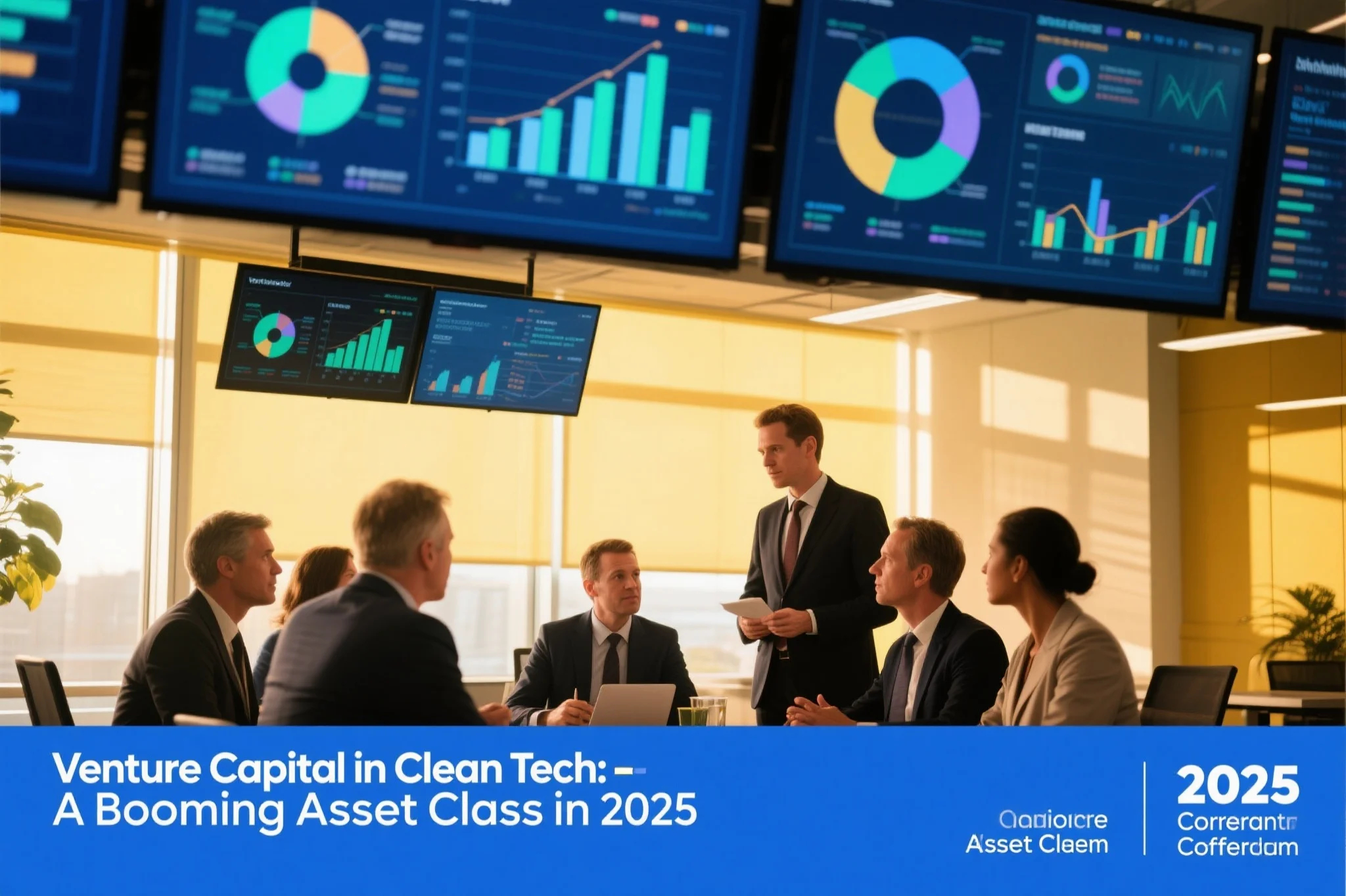
the resurgence of clean tech venture capital
After a decade of cautious optimism, venture capital is flooding into clean tech at unprecedented levels, transforming what was once considered a niche sector into one of the most dynamic asset classes of 2025. This renaissance differs fundamentally from the first clean tech wave of the early 2000s, with today’s investors benefiting from technological maturity, favorable policy tailwinds, and hard lessons learned from previous cycles. The sector’s growth reflects broader shifts in ESG investing priorities, where environmental impact now converges with compelling financial returns rather than requiring concessionary tradeoffs. What’s emerging is a new generation of green startups that combine Silicon Valley’s innovation velocity with industrial sector discipline, attracting capital from traditional VC firms and institutional investors alike.
The current investment thesis in clean tech has evolved beyond simple renewable energy plays to encompass seven key verticals: energy storage, carbon capture, sustainable materials, circular economy platforms, precision agriculture, green hydrogen, and climate analytics. Each represents a multi-billion dollar addressable market where technological breakthroughs can create category-defining companies. Unlike the previous generation of capital-intensive hardware plays, many modern green startups leverage software, AI, and advanced materials science to achieve scalability with relatively modest capital requirements. This shift has made venture capital far more comfortable with the sector’s risk profile while maintaining exposure to what could become some of this decade’s most valuable high-return assets.
investment themes driving the clean tech boom
Several powerful macroeconomic trends are converging to make clean tech one of the most compelling venture capital opportunities in 2025. The global energy transition represents perhaps the largest capital reallocation in history, with an estimated $100 trillion needed to achieve net-zero targets. Simultaneously, supply chain resilience concerns have created fertile ground for sustainable materials and circular economy innovations. Perhaps most importantly, the economics of clean technologies have reached inflection points where they frequently outcompete legacy alternatives without subsidies – solar and wind power achieved this years ago, with battery storage, green hydrogen, and sustainable aviation fuel now reaching similar milestones.
These secular trends have transformed ESG investing from a compliance exercise into a genuine performance driver. Limited partners now view environmental impact as a proxy for future-proofing rather than a constraint, recognizing that regulatory changes and consumer preferences will favor sustainable solutions. The most successful green startups of this cycle understand how to monetize both their environmental benefits and superior unit economics, making them attractive to growth investors beyond impact-focused funds. This dual appeal helps explain why clean tech has become one of the few sectors where early-stage valuations still appear reasonable relative to long-term potential, particularly when compared to frothier areas like AI or web3.
geographic hotspots for clean tech innovation
The geography of clean tech innovation has expanded dramatically since the sector’s first wave, creating new hubs for venture capital activity beyond the traditional Silicon Valley-Boston corridor. Northern Europe has emerged as a leader in offshore wind and carbon capture technologies, while Israel’s ecosystem excels in water tech and agricultural innovation. Asia-Pacific markets, particularly China and South Korea, dominate battery supply chain innovations and electric vehicle infrastructure. Even historically overlooked regions like the American Midwest are thriving as centers for next-generation biofuels and grid modernization technologies.
This geographic dispersion reflects both the diverse applications of clean technologies and the importance of local policy environments in shaping ESG investing opportunities. Savvy investors now track regional incentive programs with the same intensity as technological breakthroughs, recognizing that supportive regulatory frameworks can accelerate commercialization timelines for green startups. The most sought-after founders combine technical vision with policy fluency, enabling them to navigate complex incentive landscapes while building fundamentally sound businesses. This global yet localized nature of clean tech innovation helps explain why the sector offers such rich potential for high-return assets – winners can emerge from unexpected places, creating opportunities for investors with specialized geographic knowledge.
the new playbook for clean tech venture success
Today’s most successful clean tech investors have radically departed from the sector’s first-wave playbook, avoiding the capital-intensive project finance models that doomed many early funds. Instead, modern venture capital approaches emphasize capital efficiency, leveraging advances in materials science and digital technologies to reduce development costs. The new model focuses on asset-light business designs where possible – software platforms for energy optimization rather than generation assets themselves, or novel catalysts that improve existing industrial processes rather than entirely new facilities.
This refined approach has made clean tech far more compatible with traditional VC return profiles while maintaining exposure to the sector’s enormous addressable markets. The best ESG investing teams in this space now combine deep technical due diligence with commercial pragmatism, favoring green startups that can achieve early revenue through enterprise sales rather than relying on multi-year R&D timelines. They’ve also become adept at identifying non-dilutive funding sources like government grants and strategic partnerships that extend runway without excessive equity dilution. These evolved strategies help explain why clean tech has transitioned from a niche impact category to a legitimate source of high-return assets in diversified venture portfolios.

corporate participation in clean tech venture
The surge in clean tech investment activity has drawn unprecedented participation from corporate venture capital arms, particularly in energy, automotive, and industrial sectors. Unlike traditional corporate VC that often prioritizes strategic alignment over financial returns, today’s corporate investors recognize that clean technologies represent existential opportunities (or threats) to their core businesses. This has led to more founder-friendly investment terms and faster decision cycles as corporates compete with financial investors for access to the most promising green startups.
This corporate participation creates unique opportunities within the broader ESG investing landscape. Strategic investors often provide valuable commercialization pathways through pilot programs and offtake agreements that can dramatically accelerate a startup’s trajectory. However, the most sophisticated founders carefully balance corporate and financial investors to maintain optionality, recognizing that overly restrictive partnerships can limit future exit opportunities. For pure-play financial VCs, corporate interest serves as both validation and competition – while it confirms market potential, it also means paying higher valuations for what could become this decade’s most valuable high-return assets.
risk factors and due diligence imperatives
Despite its growth potential, clean tech remains a complex sector for venture capital investors, requiring specialized due diligence approaches. Technology risk represents just the starting point – investors must also evaluate regulatory dependencies, supply chain vulnerabilities, and potential policy reversals. The most common pitfall remains underestimating commercialization timelines, particularly for hardware-intensive solutions that require safety certifications or industry approvals. Successful ESG investing teams in this space typically include operational partners with relevant industry experience who can pressure-test engineering roadmaps and manufacturing plans.
Another critical consideration is intellectual property strategy, particularly for green startups operating in sectors with entrenched incumbents. The most valuable clean tech companies develop comprehensive IP moats that protect not just core technologies but also manufacturing processes and data assets. Investors increasingly favor business models that create recurring revenue through services or consumables rather than one-time equipment sales, as these tend to command higher multiples and represent more durable high-return assets. Perhaps most importantly, successful clean tech VCs recognize that winning in this sector requires patience – while software deals might exit in 5-7 years, many clean tech winners need 8-10 years to reach maturity.
exit pathways for clean tech ventures
The exit environment for clean tech companies has matured significantly since the sector’s first wave, providing venture capital investors with multiple liquidity options. Strategic acquisitions remain the most common pathway, particularly as traditional energy and industrial companies scramble to decarbonize their operations. However, the public markets have also become increasingly receptive to clean tech stories, with recent IPOs demonstrating that investors will reward companies with credible paths to profitability and scalable technologies. Special purpose acquisition companies (SPACs), while less prevalent than during their 2021 peak, continue to provide alternative routes to public markets for certain types of green startups.
An emerging trend in ESG investing involves continuation funds that allow early investors to partially exit while maintaining exposure to companies’ growth trajectories. These structures recognize that many clean tech winners require longer hold periods than traditional VC timelines allow. The most successful investors develop flexible exit strategies that can adapt to changing market conditions – they might take a company public but maintain ownership through the transition, or sell a majority stake while retaining participation in future upside. This flexibility is particularly valuable in clean tech, where many of the most promising high-return assets are still in relatively early stages of market adoption.
the future of clean tech venture capital
As we look toward the second half of the decade, clean tech appears poised to cement its position as a core pillar of global venture capital activity. Several converging factors suggest the current boom has staying power: technological maturity curves are accelerating, policy support appears durable across political cycles, and consumer demand for sustainable solutions continues growing. Perhaps most importantly, the economic case for clean technologies has reached an inflection point where they frequently represent superior solutions regardless of environmental benefits – making them resilient to potential ESG backlash or greenwashing concerns.
The next frontier in ESG investing will likely involve deeper integration of climate analytics into investment decision-making, with sophisticated investors using granular carbon accounting to identify the most impactful green startups. Another emerging area involves “climate alpha” strategies that seek to generate high-return assets by anticipating regulatory changes and technological tipping points. What’s clear is that clean tech venture has evolved from a niche impact category into a mainstream investment thesis – one that combines the scale potential of traditional energy with the innovation velocity of technology, creating unique opportunities for investors who understand its nuances.